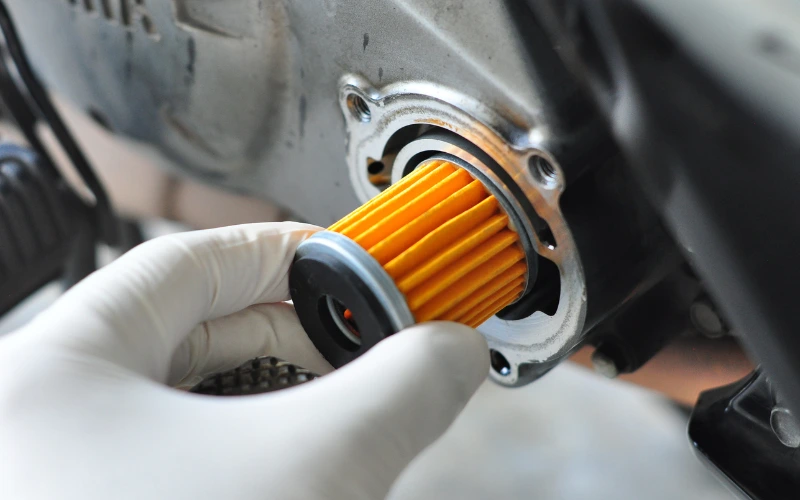How to Change the Oil in Your Motorcycle
01 Aug 2025

Changing oil on a motorcycle is an essential maintenance task that any rider can carry out themselves. Regular oil changes with the right oil are crucial for maintaining motorcycle performance and engine health. They help improve engine efficiency and longevity, enhance fuel efficiency, reduce maintenance costs and keep emissions at the right level.
In this guide, we share simple steps for changing your motorcycle engine oil. We’ll also share essential safety tips, tool recommendations and advice on how to choose the right oil for your vehicle.
Signs your motorcycle needs an oil change
One of the most common indicators you need an oil change is the condition of the oil itself. Here are some signs you should look out for:
- Dark, thick, or opaque oil, often with visible sludge deposits, means that the oil has degraded
- You may experience decreased engine performance, hear unusual engine noises, or smell burning oil
- An oil leak is also a sign that maintenance is overdue and should be addressed immediately to prevent further issues
What tools you need to change motorcycle engine oil
A motorcycle oil change can be carried out by most people, so here are the tools and supplies you need on hand to do the job properly:
- Socket wrench set
- Torque wrench
- Oil filter wrench
- Funnel
- Oil drain pan
- Oil filter drain tray
- Protective gear (gloves, safety glasses)
- New oil filter
- New motorcycle oil
- Replacement drain washer (if applicable)
- Rags or cloths
Read our motorcycle maintenance checklist to prevent issues from occurring and address oil changes before they lead to bigger problems.
The recommended frequency of changing motorcycle engine oil will depend on a few different factors. Think about the following:
Preparing your motorcycle for an oil change
Before you begin, there are a few simple preparation steps that can make your oil change more straightforward.
- Park on a safe, level surface - this will give better stability while you’re working on the motorcycle and make draining the oil a safer process.
- Warm up your motorcycle to its normal operating temperature in a well-ventilated area - this will allow the oil to drain more easily and thoroughly.
- Wear protective gear - such as gloves and eye protection.

How to change motorcycle oil: step-by-step guide
Step 1: Loosen and remove the drain plug
You may need to remove belly pans to access the area you need. Unlike the screw-on oil filler cap, the oil drain plug will usually need a socket wrench and a torque wrench to loosen it.
Place a drain pan underneath the opening to collect the old oil. Loosen the plug until you can do the last few turns by hand. The oil is likely to flow out quickly once the plug is removed, so ensure that your drain pan is already in place.
Step 2: Remove the oil filter
A motorcycle’s oil filter is usually located on the side or bottom of the engine. Place the drain tray underneath the filter once you have identified it. You will usually need a specific oil filter wrench to remove the filter from the motorcycle.
Step 3: Drain the oil
Allow the oil to drain completely. This will usually take several minutes.
Step 4: Clean the drain plug and filter mounting surface
Use a rag to remove any dirt, debris or old gasket material from the area and the plug.
Step 5: Install the new oil filter
Use a thin coat of fresh oil to lubricate the gasket before putting the new filter into place. Tighten the new filter to the manufacturer’s recommendations with your fingers and the wrench.
Step 6: Replace the drain washer and plug
Put the drain washer in place and start tightening the plug by hand to avoid cross-threading.
Then finish tightening the plug with a wrench to the manufacturer’s recommended torque, being careful not to overtighten.
Step 7: Add new oil
Check your owner’s manual to see how much oil to add and use the funnel to add the new oil to the reservoir.
Once you have added new oil, start up the motorcycle and run it for a few minutes to give the new oil a chance to be distributed through the engine.
Step 8: Check the oil level
Once the engine has cooled again, check the oil level with the dipstick to make sure it’s within the recommended min/max range.
Safety tips and precautions when changing motorcycle oil
Here’s some important safety tips when changing your motorcycle oil to avoid any accidents or injuries:
- Avoid contact with hot oil by wearing safety gloves and eye protection when removing the drain plug.
- Work in a well-ventilated area to reduce the chances of breathing in any unwanted fumes.
- Always dispose of used oil responsibly. Many areas have recycling centres or oil banks for this.
Use a torque wrench to ensure you don’t under-or-over-tighten any bolts.
Choosing the right engine oil for your motorcycle
Not all motorcycle engine oils are the same, and selecting the best option for your specific motorcycle and riding conditions is key to achieving optimal performance and engine protection.
Here are some factors to consider:
Check your user manual: Your motorcycle’s user manual is the most reliable source for the correct engine oil type and viscosity recommendations. Always refer to it first to ensure you’re using an oil that meets the manufacturer’s specifications.
Riding conditions and climate: Consider the typical climate and riding conditions for most of your journeys. For example, synthetic oils often perform better in extreme temperatures, while mineral oils may be sufficient for moderate conditions.
Motorcycle make, model and age: Older motorcycles may benefit from mineral oils, while newer models often perform better with synthetic alternatives.
Mineral engine oils are often suited to older motorcycles but do tend to degrade at a faster rate than synthetic alternatives, so more frequent changes are needed.
Synthetic engine oils are often more expensive, but usually need to be replaced less often while offering more performance benefits, especially in more challenging environments.
You’ll need to decide on the viscosity of engine oil that you want to use. Find out more about viscosity grades in our article to help you choose the right engine oil for your motorcycle.
Additional motorcycle oil change tips
- Always follow the manufacturer’s instructions when it comes to recommended oil change intervals to keep your motorcycle engine in the best possible condition.
- Replace the oil filter every time you replace the oil in your motorcycle to prevent clogging and contamination, which can cause real damage to your engine.
- Store your motorcycle in a cool dry environment, away from direct sunlight and extreme temperatures, to minimise oil degradation and evaporation.
If you find that you have an unexplained oil leak or you think that your oil has degraded to the point that your engine has been damaged, it’s worth consulting a mechanic to solve the issue.

Frequently asked questions about how often you should change the engine oil in your motorcycle
The recommended frequency of changing motorcycle engine oil will depend on a few different factors. Think about the following:
How many miles do you ride?
If you cover more mileage, the more frequently you’ll have to do an oil change.
What type of engine oil do you use?
Different kinds of engine oil break down at different rates. This could depend on the climate of the country you are riding in or on the vehicle you have, for example.
What kind of motorcycle journeys do you do?
Stop-and-start city driving will have different demands on your motorcycle’s engine compared to longer journeys at higher speeds.
What are your motorcycle manufacturer's recommendations?
Oil change intervals are recommended by the manufacturer and will depend on the specific model of your motorcycle.
Regular maintenance is key
Changing your motorcycle engine oil is a key part of ongoing maintenance and many owners find it a straightforward and rewarding task to do themselves.
Following our steps and choosing the right new engine oil to put into your motorcycle can help improve motorcycle performance and keep your ride running at its best for longer.
Explore our range of motorcycle engine oils and find an option for all types of motorcycles and circumstances.

